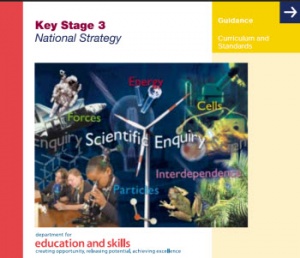Using Models and Modeling in Science: Difference between revisions
SimonKnight (talk | contribs) (Created page with "{{Rinfo |title= Using Models & Modeling in Science |topic= Models |subject= Science, Teacher Education |resourcenumber=TE0060 |age= Secondary |content= The resource comprises ...") |
mNo edit summary |
||
| Line 1: | Line 1: | ||
{{Rinfo | {{Rinfo | ||
|title= Using Models & | |title= Using Models & Modelling in Science | ||
|topic= Models | |topic= Models | ||
|subject= Science, Teacher Education | |subject= Science, Teacher Education | ||
|resourcenumber=TE0060 | |resourcenumber=TE0060 | ||
|image=Climateforgrouptalk-dfes1.jpg | |||
|age= Secondary | |age= Secondary | ||
|content= The | |content= This 23-page study unit offers practical examples of using models for teaching science. It distinguishes between analogies such as 'energy as money' and 'digestive enzymes as scissors' and models such as using spheres to show day and night. It tells about different types of model as tools for explaining ideas. The final major part of the unit looks at using 'models' to give students an opportunity to write at length. | ||
|toc=<br /> | |||
* Why is using a range of models effective? (Available separately) | |||
* When to use different models. | |||
* Modelling and scientific writing; | |||
* Demonstrations in science teaching | |||
|strategy= | |strategy= | ||
|Learning Objectives= The document | |Learning Objectives=The document include activities and practical examples with the objective that you should see ways to use models effectively in science lessons, and select models with a critical eye. | ||
|additional resources= | |additional resources= | ||
|useful information= | |useful information= | ||
|related resources=See other {{tag|DfEScience}} resources | |related resources=See other {{tag|DfEScience}} resources | ||
|other= | |other= | ||
|format=.doc | |format=one complete 28-page DfES document (Ref: DfES 0700-2004 G) in editable format (.doc) | ||
|resources=[[file:Using models and modeling.doc]] | |resources=[[file:Using models and modeling.doc]] | ||
[[File:Usingmodelsandmodelling.jpg|640px|link=|preview]] | |||
}} | }} | ||
[[Category:Secondary]] [[Category:Science]][[Category:Teacher Education]][[Category:External Resource]] | [[Category:Secondary]] [[Category:Science]][[Category:Teacher Education]][[Category:External Resource]] | ||
{{DfEScience}} | {{DfEScience}} | ||
Revision as of 20:22, 18 September 2012
About. This 23-page study unit offers practical examples of using models for teaching science. It distinguishes between analogies such as 'energy as money' and 'digestive enzymes as scissors' and models such as using spheres to show day and night. It tells about different types of model as tools for explaining ideas. The final major part of the unit looks at using 'models' to give students an opportunity to write at length.
Pedagogical content. This resource describes the types of models(tool) that are useful in science teaching, distinguishing between scientific models and teaching models. Using numerous examples, it highlights each model's strengths and limitations. (edit)
| Resource details | |
| Title | Using Models & Modelling in Science |
| Topic | [[Topics/Models|Models]] |
| Teaching approach | [[Teaching Approaches/|]] |
| Learning Objectives | The document include activities and practical examples with the objective that you should see ways to use models effectively in science lessons, and select models with a critical eye. |
| Format / structure | one complete 28-page DfES document (Ref: DfES 0700-2004 G) in editable format (.doc) |
| Subject | [[Resources/Teacher Education|Teacher Education]], [[Resources/Science|Science]] |
| Age of students / grade | [[Resources/Secondary|Secondary]], [[Resources/Higher|Higher]] |
| Table of contents |
|
| Related ORBIT Wiki Resources | See other DfEScience(i) resources |
| Files and resources to view and download |
|
- This resource has been harvested by ORBIT and made into a document that can be edited from the DfES resource "Strengthening teaching and learning in science through using different pedagogies" (ref:0703-2004)
- The original can be downloaded from the 'National Archive' here http://webarchive.nationalarchives.gov.uk/20110809101133/nsonline.org.uk/node/154651.
- We have, in places, edited these resources to remove references to obsolete legislation, guidance, or websites or to otherwise adapt them to our purposes. In particular, we have separated out key elements of the resources into separate 'ideas'.


